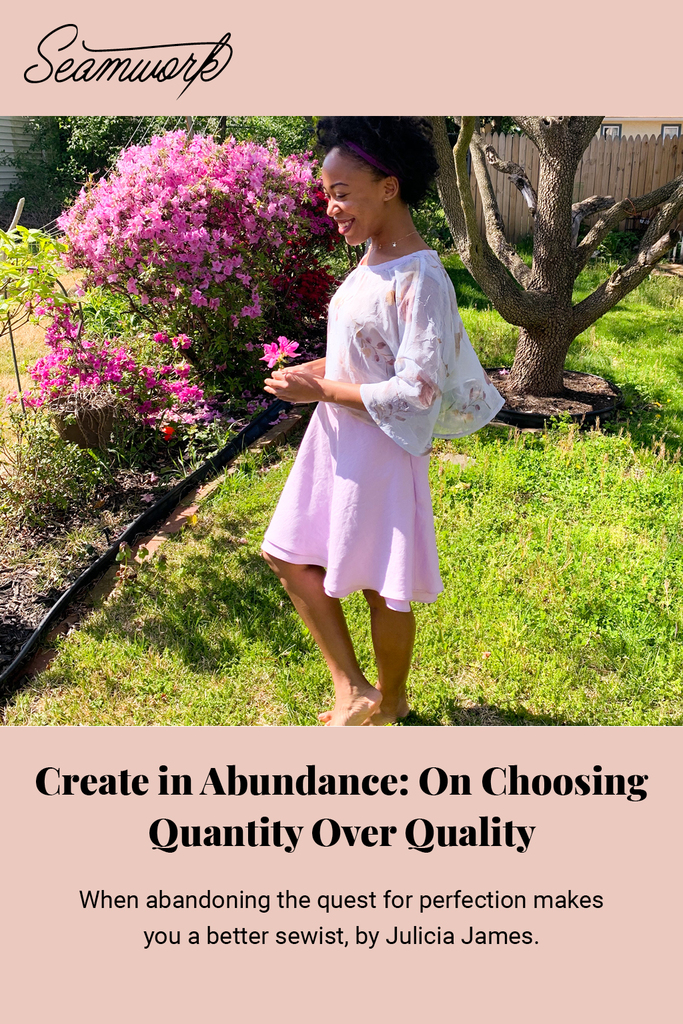I imagined myself sashaying down a sunny street in a purple Catarina dress, the skirt dancing about my legs in the wind. I dreamed of wearing a sassy Layton romper to a cookout, laughing as I held a paper plate topped with chips and a vegan hot dog. I could see myself walking down the halls of my office in a chic pair of well-tailored Moji pants, laptop in one hand and a hot mug of tea in the other.
But I felt terrified of buying fabric and sewing these garments myself. What if I messed up?
When learning any skill in life—how to drive, how to take care of a succulent, how to do the Savage TikTok dance—we have to let go of the desire to be perfect at it the first time. We have to embrace the fact that our early attempts will likely suck. Sometimes, as sewists, we can become paralyzed at the prospect of sewing a new garment or tackling a new skill.
And so, I have a radical proposition: let’s abandon the quest for perfection in sewing. It’s time to give it up. I want to make an argument for pursuing quantity over quality in our sewing lives. The perfectly sewn invisible zipper, the flawlessly balanced hem, the blouse impeccably cut on the exact straight of grain—does it exist? Perhaps, yes—in the studios of dressmakers who have been sewing for decades or in fashion houses with closely-guarded hundred-year-old tailoring secrets. But is it worth chasing after this perfection if we don’t feel the freedom to create, make mistakes, learn from them, and try again?
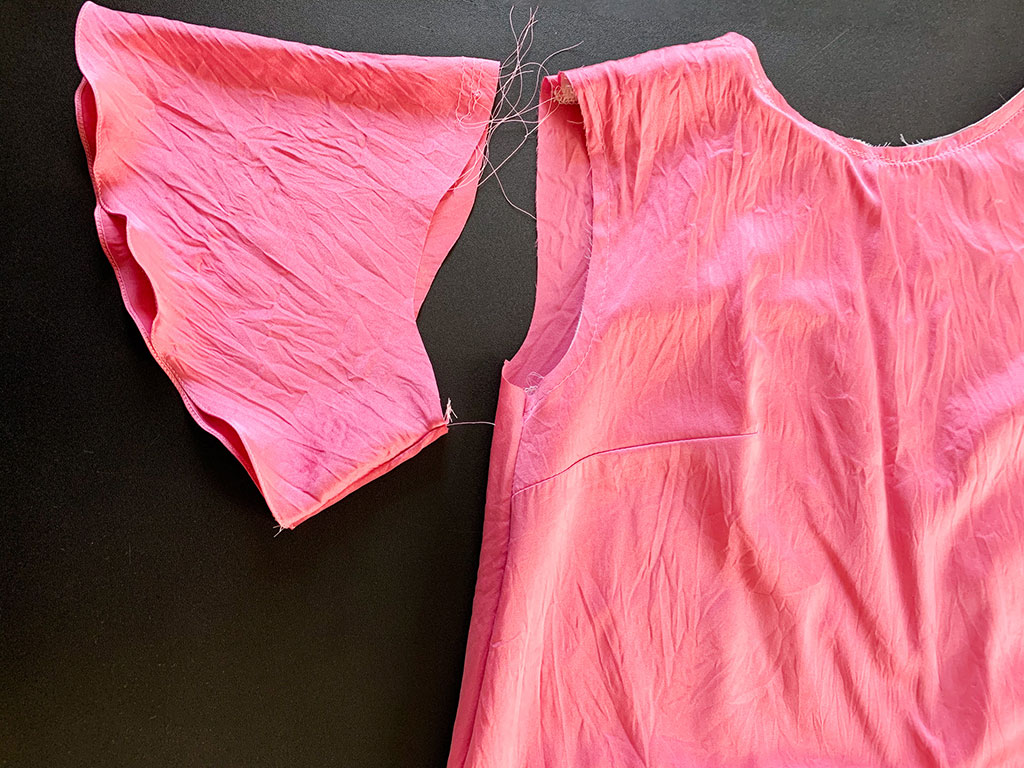
I want to be clear. When I say I want to champion the value of quantity over quality in sewing, I’m not advocating for willfully cranking out sloppily sewn projects without any attention paid to detail. Rather, I want to make a case for sewing project after project and practicing until our skills become exquisite or exquisite-adjacent. Quantity —consciously sewing in abundance—leads to quality: better fitting, beautifully draped garments.
When we were kids, we didn’t give up singing the alphabet if we didn’t sing it perfectly the first time. We sang it again and again (quantity) until we got it right (quality). To sew quality garments, we have to sew in large quantities. We have to make mistakes in abundance, and then keep it moving. We need to put in the work of making garment after garment so that our dressmaking skills can improve.
Give Yourself the Freedom
to Make Mistakes
The first Seamwork pattern I worked up the nerve to make was the Moji pants. I bought a few yards of lavender linen. I had some cotton muslin on hand, so I made a mockup of the pants first. That initial mockup was a disaster. The pants fit properly in the front, but as far as the back was concerned, I was a little too well-endowed for them to fit properly (cue Bootylicious by Destiny’s Child). I picked up The Complete Photo Guide to Perfect Fitting and religiously read the section on deep buttocks adjustments. I watched a few YouTube tutorials. Armed with this newfound knowledge, I made a second mockup in muslin. This pair also fit too tight in the back. I felt so stressed and disappointed in myself. I had messed up both muslins, so it was evident that I was terrible at making pants and no good at fitting either.
In the book Art & Fear: Observations on the Perils (and Rewards) of Artmaking, authors David Bayles and Ted Orland write, “Making art provides uncomfortably accurate feedback about the gap that inevitably exists between what you intended to do, and what you did.” They argue that most of the artwork we produce is to teach us “how to make that small fraction of your artwork that soars.” With my Moji pants, it may have been better to reframe my experience and see making these pants as a learning tool, not a testament to my lack of fitting prowess.
It didn’t feel good when the Moji pants I had in my mind looked nothing like the pants that I actually made. But it was a little bit silly for me to think that the first time I made a pair of woven pants, they would turn out perfectly. They are a notoriously tricky item to sew and fit. In this instance, giving myself the freedom to make mistakes could have meant making a third muslin or scratching the project entirely and trying a new pattern. Instead, I took a break from sewing for several weeks. I was too worried about my next project turning out all wrong, obsessed with “quality.”
When we sew, every time we make a stitch, put in a buttonhole, sew a crooked hem, trace a dart, seam rip a pant leg—we are learning to become better at our craft. We are learning the very lessons we need to sew a beautiful garment, even if our current work-in-progress may look a little misshapen. The more we sew, the more we learn.
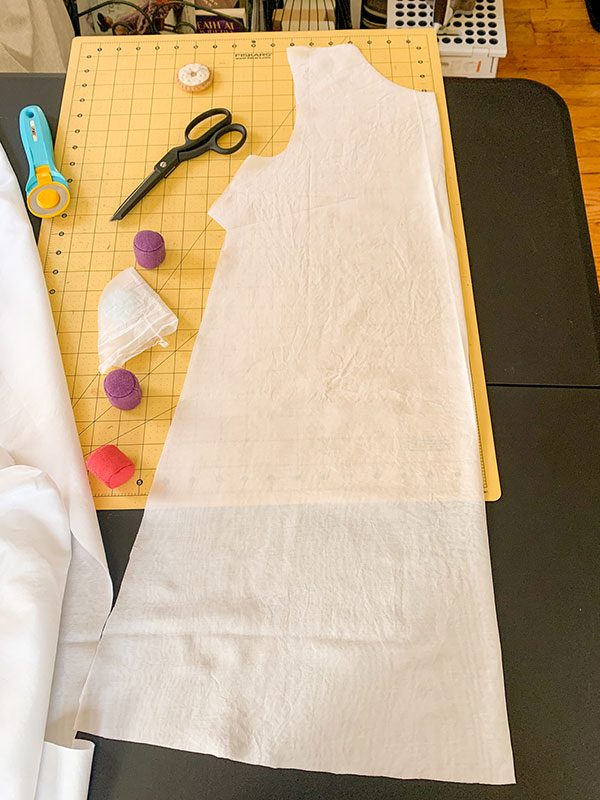
Repetition is the Key to Mastery
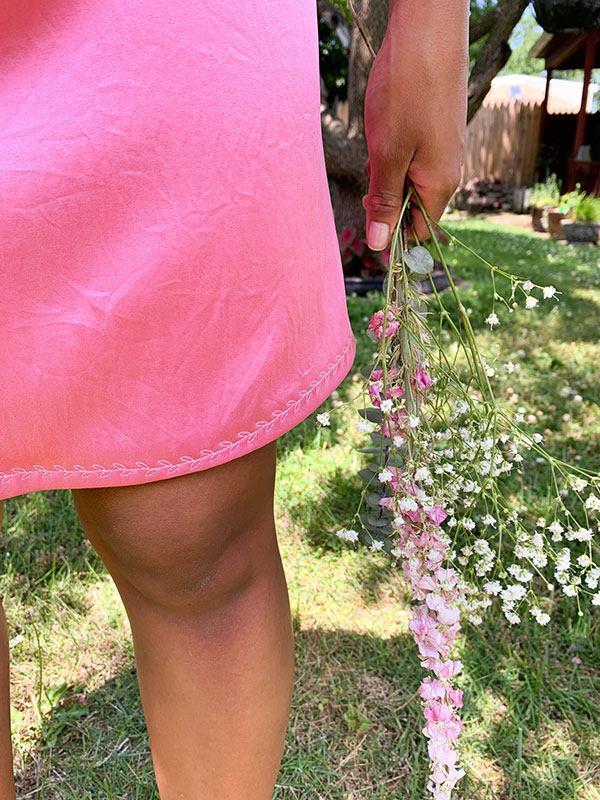
In the book Atomic Habits, the author James Clear shares a story about a beginner photography class that challenges the commonly-held beliefs we often have about this whole quantity vs. quality conundrum.
On the first day of class, a professor at the University of Florida separated students into two groups. The first group, the “quantity” group, would receive a final grade based on how many photos they took throughout the semester. To receive an A, they would have to take at least 100 photos. The second group, the “quality” group, only needed to submit one photo to pass the class. To get an A, this one photo had to be flawless.
When it was time to distribute final grades, the professor discovered that the students in the quantity group had taken all of the best photos. Why? The students in the quantity group had been taking action. By being pushed to take as many photos as possible throughout the semester, they learned firsthand about storytelling, composition, and all the different elements required to take an excellent photo. The students in the quality group, however, “sat around speculating about perfection."
Thinking, theorizing, and researching is not the same as doing. When I watch a YouTube tutorial on creating bias tape, I can conceptualize what the steps are and even trick myself into thinking the process is easy. However, until I press a fat quarter of cotton voile, fold it into squares, cut strips on the bias, and sew the strips together at a 90-degree angle, my hands won’t have the muscle memory of that skill. I cannot truly grasp this process until I attempt to do it myself. Doing takes a skill from being conceptual (just in your head) to a reality (existing in your muscle memory).
Take a Chance—Sew that First Stitch!
Silk charmeuse is one of my favorite fabrics—I like the slippery, sumptuous feel of it against my skin and how it drapes and flows with the movement of the body. But charmeuse is an expensive fabric, and I always felt like my skills weren’t up to par.
One day, I challenged this mentality. I realized this: I have been sewing since I graduated college. I have a certificate in fashion design from Moore College of Art & Design, and I took eveningwear and pattern-drafting classes at Made Institute. I even designed a dress that walked the runway in the Old City segment of the 2016 Fall/Winter Philadelphia Fashion Show. If my sewing skills weren’t “good enough” to work with silk charmeuse, when would they ever be good enough? How would I know if I didn’t even try?
I made a plan. Step one: save up for silk charmeuse. Step two: work with cheaper fabrics that act like silk charmeuse (e.g., polyester charmeuse). Step three: buy silk!
I bought pink silk charmeuse to make the Kenedy dress. An instructor at Made told me that if you wash silk, you can continue to wash it in the future instead of paying to dry clean it.
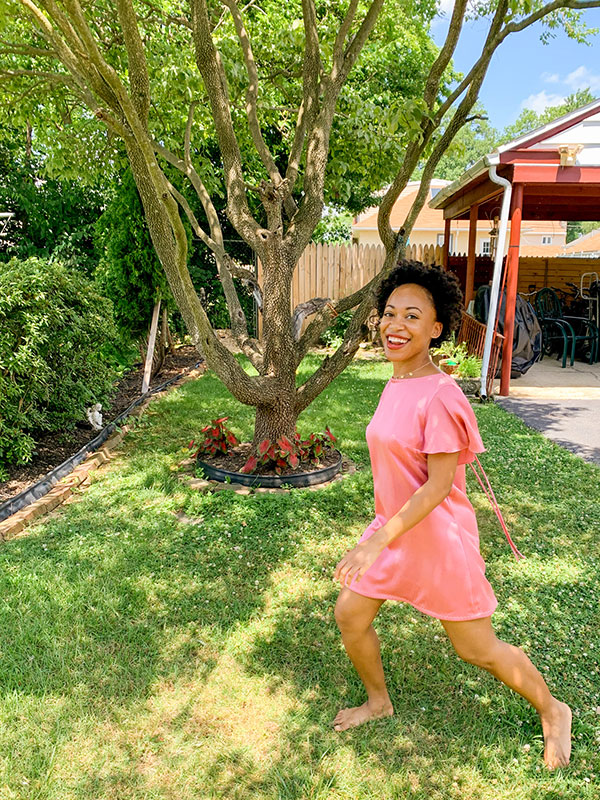
Had I ever washed silk before? No. Did I know if it would turn out okay? Absolutely not. But I threw caution to the wind and a hefty swatch of the silk charmeuse in the washer. It survived the wash, and I hung it to dry. Although the color darkened slightly, the fabric held up beautifully. I threw the rest of the charmeuse in the wash, and the rest is history.
I’m in love with my Kenedy dress. The decorative stitching on the hem is a bit wobbly, the shoulder seams aren’t perfectly symmetrical, and the underlining is a bit bubbly. But the dress is a dream to me. It taught me that I could only become better at sewing silk by actually sewing silk—not by reading about it or watching a dozen YouTube videos.
The Hardest Part is Showing Up
It takes time and patience to crank out project after project. It takes grit to keep going, especially when some of my projects turn out tragically ill-fitting. I can’t stop sewing if one pair of pants or a romper doesn’t turn out the way I want it to. Nothing is perfect. I have to keep going and sewing more things. Sometimes a project will be a dud, and I have to learn to be okay with that. Other times, the garment that I sewed may look even better than what I had envisioned.
When I used to go to yoga class regularly pre-pandemic, the instructor would often welcome us by saying, “The hardest part of class is over. You made it to the mat.” This shift in perspective helped me to realize that by showing up to class, I had already scored a win. Anything else that I did in the class was the cherry on top. Twisting my arms and legs into a flawless eagle pose wasn’t what mattered. What truly mattered was showing up to every class so that I could incrementally improve my eagle pose: progress, not perfection, is what made me a good yogi.
Similarly, the hardest part of sewing is showing up. This can be particularly difficult if you have a hectic schedule. But once you make it to your sewing machine, the worst is over. It doesn’t matter whether or not the sleeves you’re working on are eased in seamlessly. You wouldn’t get down on a yoga mat and expect to do bridge pose perfectly the first time. And even if you do nail the pose as a newbie, there will be some days that your body just isn’t feeling it and won’t cooperate. And that’s okay. What matters is that you’re using your skills, you’re learning, and you’re not afraid to course-correct if you make mistakes along the way.

It takes time and patience to crank out project after project. It takes grit to keep going, especially when some of my projects turn out tragically ill-fitting. I can’t stop sewing if one pair of pants or a romper doesn’t turn out the way I want it to. Nothing is perfect. I have to keep going and sewing more things.
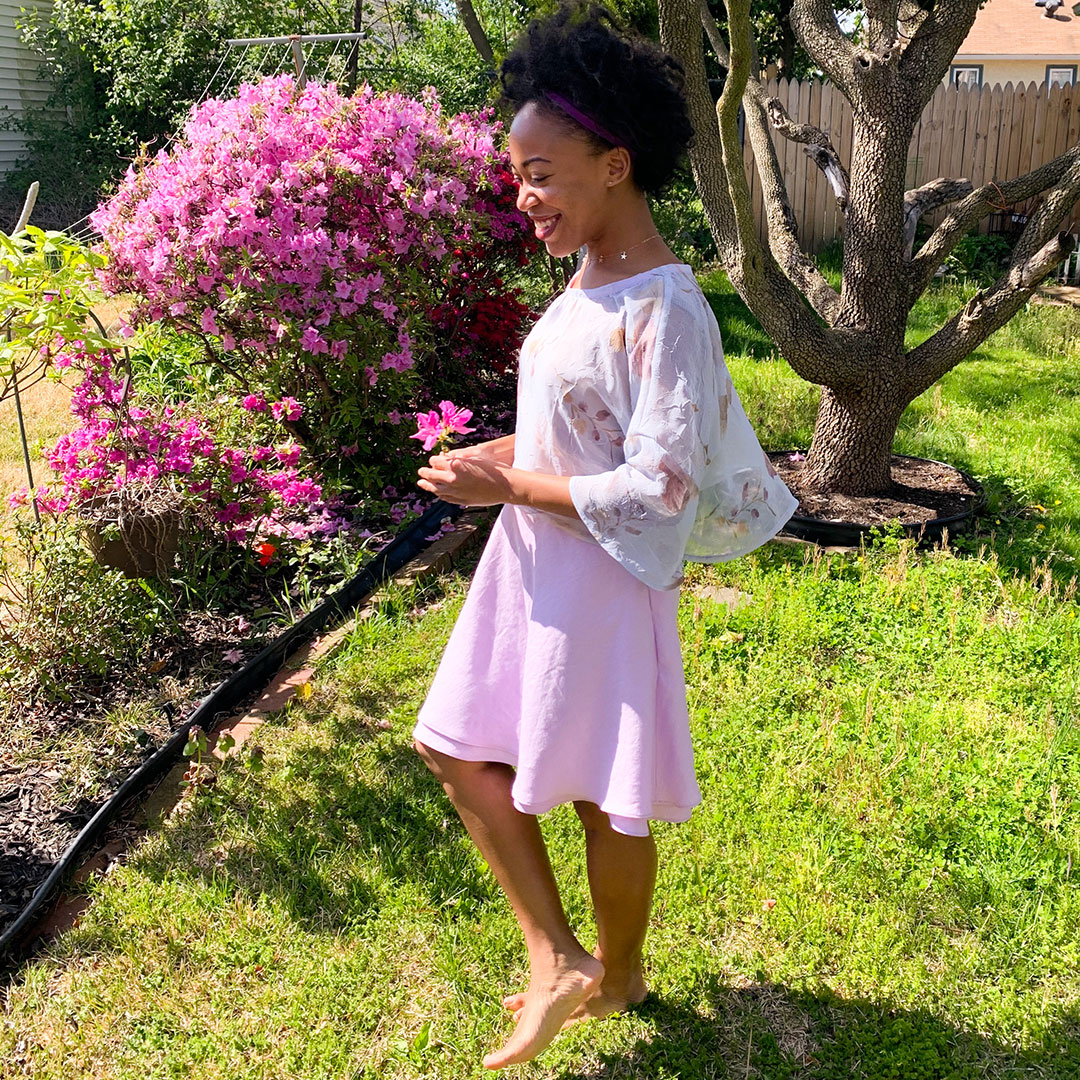
If you want to make sewing a regular practice, try picking a time each week to consistently sew. Start where you are, and keep going. What matters most is showing up and doing the work to the best of your ability, not being perfect.
Quantity Wins the Day
In the words of the great Evelyn From The Internets, “When you finish something, you have the knowledge of what it takes." When we sew regularly and repeatedly try new things, we exponentially improve our dressmaking skills and expand our knowledge in different areas. Aiming for quantity—sewing as much as possible—inevitably leads to higher quality garments. So, let’s renounce the quest for perfectionism entirely. Instead, let’s show up excited to make mistakes, learn new skills, and sharpen existing talents.
Try your own quantity vs. quality experiment, and get out all the patterns that you’ve been itching to create! Dust off the patterns that bring you joy, inspire you to daydream, and that you can already see yourself wearing. Make that skirt or that top or those slacks! Write a list of the next three patterns you want to create. And start. Cut into that fabric. Stay-stitch those necklines. Pin the front and back bodices together. Let’s get sewing!



